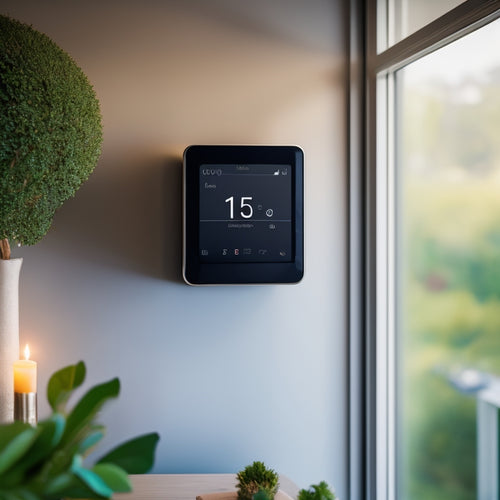
Why Roof Evaluation Is Crucial for Solar Success
Share
When considering solar energy, it's crucial to evaluate your roof's condition before installation. You'll want to assess your roof's age, looking for signs of wear, damage, or needed repairs. A thorough evaluation guarantees your roof can support the added weight and stress of solar panels, determining if it's structurally sound and identifying potential issues before they become major problems. By doing so, you'll avoid costly reinstallation and guarantee a successful shift to renewable energy. Now, take the next step to uncover the complexities of roof evaluation and how it can lead you to solar success.
Key Takeaways
- Roof evaluation ensures solar panels are installed on a structurally sound roof, avoiding costly reinstallation and maximizing energy output.
- Assessing roof age, condition, and material compatibility prevents installation issues and ensures a long-lasting solar energy system.
- Evaluating roof size, shape, and orientation determines optimal solar panel placement, maximizing energy absorption and system performance.
- Identifying potential roof leaks and addressing them early saves thousands in future repair costs and ensures reliable solar energy benefits.
- Conducting a thorough roof evaluation helps ensure compliance with local and national codes, avoiding costly rework and ensuring a successful solar installation.
Roof Age and Condition Matter
As you consider utilizing the power of solar energy, it's essential to take a closer look at the roof that will be supporting your system. The roof's age and condition play a significant role in determining the success of your solar installation.
Conducting a thorough truck inspection, including energy audits, can help identify potential issues before installation. A roof nearing the end of its lifespan may not be the best candidate for solar panels, as it may need to be replaced soon. This could lead to additional costs and hassle when reinstalling the system on the new roof.
Timing is everything; consider installing solar panels during roof replacement to maximize efficiency and minimize future disruptions. By evaluating your roof's condition and lifespan, you can guarantee a successful and long-lasting solar energy system.
Structural Integrity Is Key
When you're considering a solar installation, you need to verify your roof can support the added weight and stress.
You'll want to evaluate the age of your roof, examining its condition to identify any potential weaknesses or vulnerabilities. This is essential, as companies like Anheuser-Busch have successfully integrated electric trucks into their fleets, and similar strategic planning is required for a successful solar installation.
A thorough weight capacity check will also help you determine if your roof can handle the additional load of solar panels.
Roof Age Matters
Your roof's age is a vital factor in determining its suitability for a solar installation, and it's important to evaluate its structural integrity before moving forward.
A roof's lifespan typically ranges from 20 to 30 years, depending on the material and quality of installation. If your roof is nearing the end of its lifespan, it may not be the best candidate for a solar installation.
In fact, installing solar panels on an aging roof can lead to costly repairs down the line. Additionally, guaranteeing high-efficiency panels with advanced photovoltaic technology can improve energy conversion rates and increase energy savings.
Timing is everything – it's important to take into account the installation timing to guarantee a successful and long-lasting solar installation.
Roof Condition Assessment
Evaluating your roof's condition is vital to guaranteeing a successful solar installation. You want to identify any potential issues that could impact the performance and longevity of your solar panels.
A thorough roof condition assessment involves inspecting for signs of wear, damage, or needed repairs. This includes checking for missing, loose, or damaged shingles, curled or buckled shingles, and signs of animal or insect infestation.
Regular roof maintenance is fundamental to extending the life of your roof and guaranteeing a smooth installation timeline. Confirming structural integrity is essential for optimizing energy production, and regular evaluations are necessary for maintenance and performance improvements solar irradiance assessment.
Weight Capacity Check
Three key elements come into play when determining a roof's structural integrity: design load, weight capacity, and material strength.
You need to ascertain your roof can support the added weight of solar panels, which is where a weight capacity check comes in. This involves calculating the maximum weight your roof can handle, considering factors like load distribution and installation techniques.
Given the high upfront installation costs of solar-powered charging stations, ranging from $2,500 to $10,000+, solar-powered systems can be a significant investment, making it vital to ascertain the roof can support the added weight.
A thorough weight capacity check gives you the freedom to install solar panels with confidence, knowing your roof can support the added weight.
- Will my roof collapse under the weight of the solar panels?
- Are there any weak points in the roof's structure that need reinforcement?
- Can the roof support the weight of snow or debris in addition to the solar panels?
- Will the installation techniques used compromise the roof's structural integrity?
Assessing Roof Size and Shape
You'll need to determine if your roof has sufficient space to accommodate the solar panels, considering factors like roof size, obstacles, and usable area.
Complex roof geometries, such as multiple skylights, vents, or irregularly shaped roofs, can also impact the feasibility of a solar installation.
Roof Space Availability
As you scope out your rooftop, take stock of the available space to determine whether it can accommodate a solar panel system.
You'll want to evaluate the roof's size, shape, and obstacles like skylights, vents, or chimneys that might limit solar panel placement.
Here are key factors to assess for best roof space availability:
-
Roof design considerations: A simple, rectangular roof with a consistent slope is ideal for solar panels.
-
Available square footage: Verify your roof has enough space to fit the required number of solar panels.
-
Obstruction-free zones: Identify areas free from obstructions like skylights, vents, or chimneys to maximize solar panel placement.
- South-facing orientation: A south-facing roof receives the most sunlight, making it the most ideal for solar panels.
Complex Roof Geometries
Most roofs aren't perfectly rectangular, and that's okay.
You'll often encounter complex roof geometries that can impact your solar installation. Evaluating roof size and shape is essential to guarantee a successful project.
Consider roof aesthetics, as unique shapes can affect energy efficiency and maintenance considerations. Design flexibility is key to maneuvering installation challenges and accommodating drainage solutions.
In addition, complex geometries can impact solar access and installation timelines. By analyzing your roof's unique shape, you can optimize energy production and reduce potential issues.
Don't let complex roof geometries hold you back from achieving energy independence – take the time to evaluate and adapt your solar design for a successful installation.
Understanding Shading and Obstructions
Shading and obstructions can greatly impact the performance of your solar panel system. They can reduce energy output, increase maintenance needs, and even void your warranty.
That's why it's essential to conduct a thorough shading analysis and obstruction mapping before installation.
Here are 4 reasons why you can't afford to overlook this step:
-
Lost energy production: Shading and obstructions can reduce your system's energy output by up to 20%.
-
Increased maintenance costs: Debris and dirt accumulation on shaded panels can lead to costly repairs and replacements.
-
System downtime: Shading and obstructions can cause your system to shut down, leaving you without power when you need it most.
- Warranty voidance: Failure to address shading and obstructions can void your system's warranty, leaving you with costly repairs and replacements.
Material Compatibility Is Crucial
Your roof's material composition plays a critical role in guaranteeing a successful solar panel installation. The type of roofing material you have can affect the installation process, maintenance requirements, and overall performance of your solar panels.
| Roofing Material | Material Selection | Installation Techniques |
|---|---|---|
| Asphalt Shingle | Compatible | Standard installation |
| Clay or Concrete Tile | Compatible with specialized | Additional structural support required |
| Metal Roofing | Compatible | Specialized installation techniques |
| Slate or Cedar Shake | Not recommended | Not recommended due to fragility |
When selecting a roofing material, it is crucial to take into account the material's durability, weight, and compatibility with solar panels. By choosing the right material, you can guarantee a seamless installation process and maximize the energy output of your solar panels.
Roof Pitch and Orientation Impact
During the solar panel installation planning phase, it's vital to contemplate the roof's pitch and orientation, as these factors greatly influence the system's energy output and overall performance.
You'll want to verify that your roof is optimized for solar energy efficiency.
Here are some key considerations to keep in mind:
-
Ideal Pitch: A pitch between 30-40 degrees is ideal for solar panels, allowing for maximum energy absorption.
-
South-Facing Orientation: A south-facing orientation receives the most direct sunlight, resulting in higher energy output.
-
Shading Obstacles: Be aware of any shading obstacles, such as trees or neighboring buildings, that may impact your system's performance.
- Installation Challenges: Complex roof geometries or steep pitches can increase installation challenges and costs, so it's important to plan accordingly.
Ventilation and Drainage Systems
As you assess your roof's potential for solar panels, another crucial aspect to evaluate is the ventilation and drainage systems, which can greatly impact the performance and longevity of your solar installation.
Proper ventilation systems guarantee that heat doesn't build up underneath your solar panels, reducing their efficiency. You'll want to check if your roof has adequate ventilation, including soffit vents, ridge vents, or power ventilators.
Similarly, functional drainage systems prevent water accumulation, which can lead to structural damage and affect your solar panels' performance. Verify that your roof's drainage systems, including gutters and downspouts, are clear and functioning correctly.
Identifying Potential Roof Leaks
Inspecting your roof for potential leaks is an indispensable step in ensuring a successful solar installation. A thorough leak detection process involves a visual examination of your roof's surface, as well as a moisture assessment to identify any hidden issues. This is essential because even the smallest leak can lead to significant damage and compromise the integrity of your solar system.
Here are 4 reasons why identifying potential roof leaks is critical:
-
Prevents Water Damage: Leaks can cause water to seep into your home, resulting in costly repairs and potential health hazards.
-
Ensures System Efficiency: A leaky roof can compromise the performance of your solar system, reducing its energy output and increasing your energy bills.
-
Saves You Money: Identifying and addressing leaks early on can save you thousands of dollars in repair costs down the line.
- Gives You Peace of Mind: A leak-free roof means you can enjoy the benefits of solar energy without worrying about the integrity of your system.
Ensuring Code Compliance and Permits
You're about to take an essential step in the solar installation process: guaranteeing code compliance and securing necessary permits. This significant task guarantees your solar panel system meets local and national code requirements, avoiding costly rework or even removal.
When submitting your permit application, be prepared to provide detailed documentation, including system design and component specifications. Compliance standards vary by jurisdiction, so it's imperative to understand local regulations and inspection processes.
Failure to comply can result in project delays, fines, or even system shutdown. By prioritizing code compliance, you'll avoid these risks and enjoy the freedom to generate clean energy with confidence.
Frequently Asked Questions
Can Solar Panels Be Installed on a Metal Roof?
You can install solar panels on a metal roof, leveraging its benefits like durability and minimal maintenance. However, you'll need to contemplate installation specifics, such as securing panels to the metal roof's structure, ensuring a watertight seal, and accommodating thermal expansion.
How Long Does a Typical Roof Evaluation Take?
Are you wondering how long you'll be stuck waiting for your roof evaluation? Typically, you'll spend about 30 minutes to an hour walking your roof with an inspector, who'll follow a careful evaluation process, involving 10-15 key steps, to give you a thorough assessment.
Are Solar Panels Compatible With Clay Tile Roofs?
You're wondering if solar panels are compatible with clay tile roofs. Yes, they are! Clay roof benefits include durability, and solar panels' weight is dispersed, ensuring a secure fit; you can enjoy energy independence without compromising your roof's integrity.
Can I Install Solar Panels on a Flat Roof?
You can install solar panels on a flat roof, leveraging its advantages like easier maintenance and more space, but be prepared to tackle installation challenges like ensuring waterproofing and managing drainage to secure a successful setup.
Do Solar Panels Void My Roof Warranty?
As you consider solar panels, you wonder: will they void your roof warranty? The answer hangs in the balance, but rest assured, most manufacturers won't void your warranty due to solar installation implications, alleviating your roof warranty concerns.
Related Posts
-

Smart Energy: Greener Homes With Connected Power Devices
You can control and optimize your energy consumption with smart energy devices, reducing your carbon footprint by up ...
-

Why EVs Inspire Earth-Conscious Home Design Choices
As you shift to an electric vehicle, you're not just switching to a greener ride, you're igniting a broader commitmen...
-

What Air Purifiers Save Energy in Work Areas?
You can cut energy costs and reduce your carbon footprint by choosing air purifiers designed with energy efficiency i...


